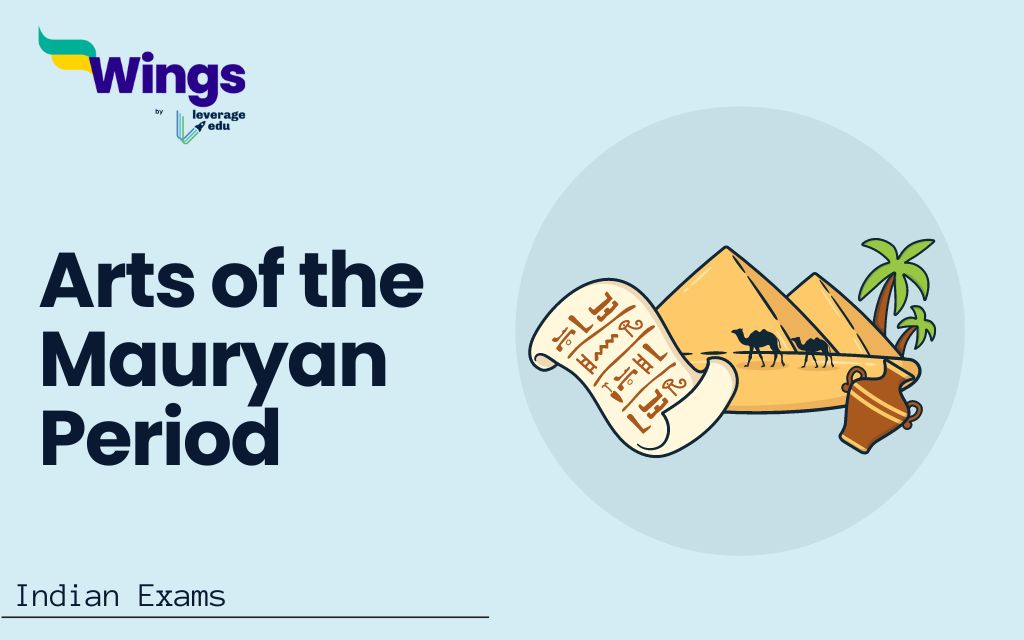The Mauryan Empire (322-185 BCE) ruled most of India for the first time. This era saw a big change in Indian art, with artists moving from using wood to carving things from stone. Kings, especially Ashoka, paid for this art.The biggest examples of Mauryan art we have today are giant pillars, stupas (domed buildings with relics inside) and caves cut into rock.Some experts say Mauryan art was influenced by Greece and Persia, empires India had contact with for a long time.This table outlines the key aspects of Arts of the Mauryan Period, highlighting its features and important examples.
| Aspect | Arts of the Mauryan Period |
| Pillar Capitals | – Rock-cut pillars unique to Mauryan Empire. – Capital adorned with animals like bull, lion, elephant. – Decorated abacus with stylized lotuses. – Lion Capital at Sarnath is exemplary. |
| Sculptures (Yakshas and Yakshinis) | – Standing figures found in Patna, Vidisha, Mathura. – Polished surface, full-round depiction. – Notable example: Didarganj Yakshi. |
| Rock-cut Architecture | – Patronized by Ashoka, mainly Buddhist. – Example: Lomus Rishi Cave at Barabar Hills. |
| Stupas and Chaityas | – Numerous stupas were built, especially during Ashoka’s reign. – Great Stupa at Sanchi, elaborately decorated. – Depictions include Buddha’s life events and Jataka stories. |
Contents
Arts of the Mauryan Period: Sculpture
Mauryan art was a big leap for Indian sculptures. Before this, most sculptures were made from wood, which doesn’t last. But the Mauryans used stone, which is why we can still see some amazing examples today.Types of sculpture during Mauryan age are listed below:
- Pillars:
- Made of stone and scattered throughout the empire.
- Topped with animal sculptures (lions, elephants, bulls, horses) symbolizing strength and power.
- Most famous pillar – Lion Capital at Sarnath with 4 lions representing power, courage, pride, and confidence.
- Yaksha and Yakshi:
- Nature spirits featured in popular art, Yaksha is male and Yakshi is female.
- Depicted with full faces and round features.
- Example: Didarganj Yakshi statue (life-sized woman holding a flywhisk)
- Rock-cut Caves:
- Used by Buddhist and Jain monks as living quarters.
- Highly polished interiors and decorative gateways.
- Example: Lomus Rishi Cave with a semicircular entrance and a rectangular hall.
- Stupas and Chaityas:
- Part of Buddhist and Jain religious complexes.
- Stupas: dome-shaped structures for enshrining relics. (Example: Great Stupa at Sanchi)
- Chaityas: rectangular prayer halls with a central stupa.
- Vihara: residences for monks.pen_spark
Must Read:Was Chandra Gupta Maurya the Founder of the Mauryan Dynasty?
Arts of the Mauryan Period:Architecture
Even though the Mauryans started using more stone and brick for buildings, wood was still super popular. There’s even a book from that time called the Arthashastra that talks about building with bricks and stone because they last longer, but it also gives tips on how to protect wooden buildings from fires – which suggests wood was still widely used.

While most buildings were wood, some important structures were built from stone. For example, archaeologists found remains of a giant hall with 80 stone pillars that probably supported a wooden roof.
Ashoka’s 7 pillar edicts are found at various locations in India and contain messages carved by Emperor Ashoka. Here’s a summary of each edict:
- Protection for People: Ashoka promises to protect his people.
- Dhamma Explained: Dhamma is defined as good deeds, kindness, honesty, and purity.
- Against Cruelty: Ashoka discourages violence, anger, and pride.
- Duties) of Officials:This edict talks about the responsibilities of government officials.
- Protecting Animals: Lists animals that shouldn’t be hunted and some that are always off-limits.
- Dhamma Policy: Explains Ashoka’s focus on following Dhamma principles.
- Spreading Dhamma: Describes Ashoka’s efforts to promote Dhamma.
Other Pillar Inscriptions:
- Rummindei: Mentions Ashoka’s visit to Lumbini (Buddha’s birthplace) and tax breaks for the area.
- Nigali Sagar: Describes Ashoka enlarging a stupa (dome-shaped monument).
Major Pillar Locations:
- Sarnath Lion Capital: Commemorates Buddha’s first sermon.
- Vaishali Pillar: Single lion with no message.
- Sankissa Pillar, Lauriya-Nandangarth, Lauriya-Araraj, Allahabad Pillar: Locations of other pillars with inscriptions.
Must Read:Everything you Need to Know About Chalukya Dynasty
Arts of the Mauryan Period:Pottery and Coins
The Mauryans used a special technique to create shiny black pots called Northern Black Polished Ware. These pots were made from fine clay and were mostly used for fancy dishes and bowls.Even though they weren’t rare, they were more expensive than other pots because people valued them so much. Archaeologists have even found broken black polished pots that were fixed with copper pins – people didn’t want to throw them away.
The Mauryans had their own money – silver coins with symbols stamped on them. These symbols might have represented the emperor or the place where the coin was made. Some even had extra marks from money changers who checked the value.The coins were mostly made of silver, but there were some copper ones too. They came in different shapes and sizes, but the most common pictures stamped on them were elephants, trees, and mountains.

FAQs
Mauryan art included sculpture and architecture.
Mauryan art is characterized by polished stone sculpture and monumental architecture.
The popular art form of the Mauryan period in UPSC exams is sculpture.
The Ashoka pillars are considered the finest examples of Mauryan art.
This was all about the “Arts of the Mauryan Period”. For more such informative blogs, check out our UPSCExams Section and Study Material Section, or you can learn more about us by visiting our Indian exams page.
 One app for all your study abroad needs
One app for all your study abroad needs














